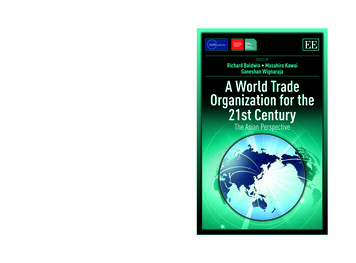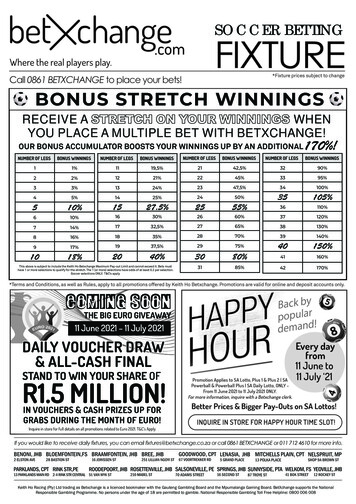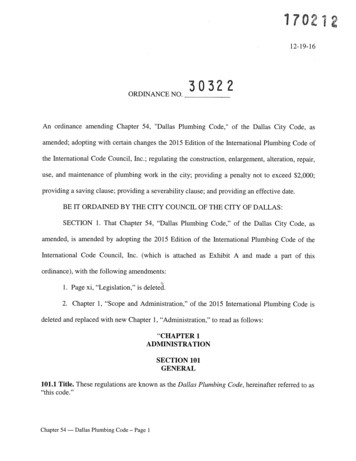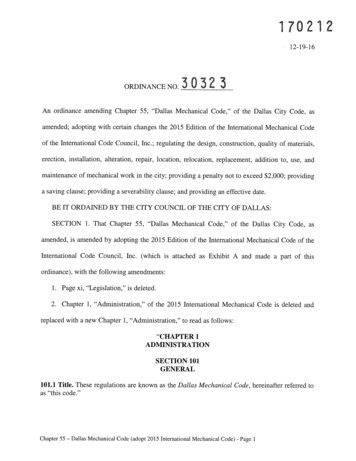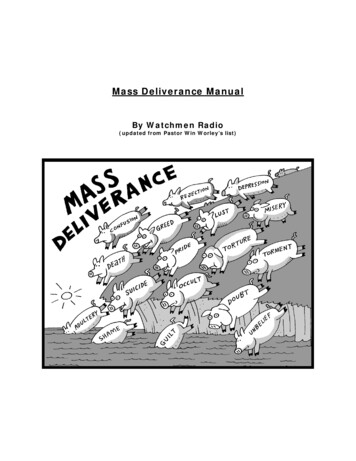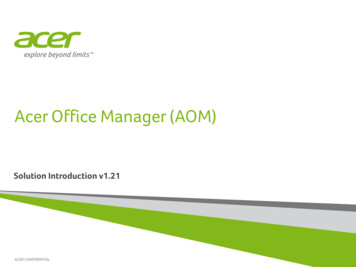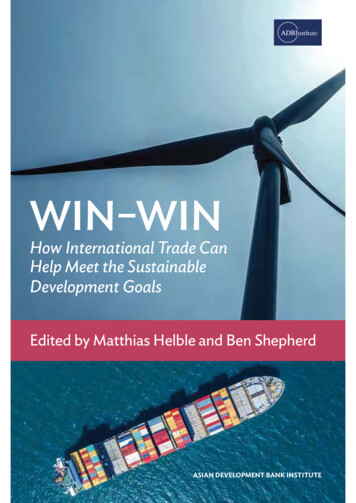
Transcription
WIN–WINHow International Trade CanHelp Meet the SustainableDevelopment GoalsEdited by Matthias Helble and Ben ShepherdASIAN DEVELOPMENT BANK INSTITUTE
Win–WinHow International Trade Can Help Meetthe Sustainable Development GoalsEdited byMatthias HelbleSenior Economist, Co-Chair, Research DepartmentAsian Development Bank InstituteBen ShepherdPrincipal, Developing Trade ConsultantsASIAN DEVELOPMENT BANK INSTITUTE
2017 Asian Development Bank InstituteAll rights reserved.First printed in 2017.ISBN 978-4-89974- 081-0 (Print)ISBN 978-4-89974- 082-7 (PDF)The views in this publication do not necessarily reflect the views and policies of theAsian Development Bank Institute (ADBI), its Advisory Council, ADB’s Board orGovernors, or the governments of ADB members. The responsibility for opinionsexpressed in signed chapters rests solely with their authors, and publication doesnot constitute an endorsement by ADBI, other international organizations andsecretariats which employ the authors, or their respective Board of Governors or thegovernments they represent, or their member countries or economies, of the opinionsexpressed in them.ADBI does not guarantee the accuracy of the data included in this publication andaccepts no responsibility for any consequence of their use. ADBI uses proper ADBmember names and abbreviations throughout and any variation or inaccuracy,including in citations and references, should be read as referring to the correct name.By making any designation of or reference to a particular territory or geographicarea, or by using the term “recognize,” “country,” or other geographical names in thispublication, ADBI does not intend to make any judgments as to the legal or otherstatus of any territory or area.Users are restricted from reselling, redistributing, or creating derivative works withoutthe express, written consent of ADBI.ADB recognizes “China” as the People’s Republic of China.Note: In this publication, “ ” refers to US dollars.The Asian Development Bank Institute, located in Tokyo, is the think tank of the AsianDevelopment Bank. The institute aims to identify effective strategies to improve policyand development management in Asia and the Pacific. We work with an extensivenetwork of partners in the region and globally to influence policies on povertyreduction, inclusive growth, the environment, regional cooperation, infrastructuredevelopment, middle-income countries, and private sector development.
ContentsFigures, Tables, and ts1.IntroductionMatthias Helble and Ben Shepherd2. From MDGs to SDGs: The Role of TradePatrick Messerlin3. Trade and the Post-2015 Development AgendaBernard Hoekmanvxxixvxvii1932PART I: Poverty, Hunger, and Inclusive Growth4. Trade and Poverty ReductionIrene Brambilla and Guido Porto615. Agricultural Trade and HungerWill Martin876. Trade and WomenBen Shepherd and Susan Stone1187.Can Trade Benefit Employment?Paul Vandenberg1398. Trade and InequalityShujiro Urata and Dionisius A. Narjoko175PART II: Sustainable Growth9. Trade and EnvironmentDale Andrew20710. Trade and Climate ChangeAndrew Prag252 iii
iv Contents11. Trade and Sustainable FisheriesU. Rashid Sumaila27212. The Trade and Water NexusAlexandre le Vernoy29413. Trade, Labeling, and Food SafetyNorbert Wilson317PART III: Education and Health14. Trade in Education Services and the SDGsAik Hoe Lim, Pamela Apaza, and Alin Horj33715. Trade in Medical Products and PharmaceuticalsMatthias Helble and Ben Shepherd37516. Trade in Health ServicesRupa Chanda400PART IV: Other Linkages between Trade and the SDGs17. Trade and UrbanizationYuan Zhang and Guanghua Wan43918. Trade, Infrastructure, and DevelopmentMarcelo Olarreaga46619. Facilitating Trade for Development: Aid for TradeWilliam Hynes and Frans Lammersen48820. Conclusion: Directions for Future Researchand Policy MakingMatthias Helble and Ben Shepherd530Index542
Figures, Tables, and BoxesFigures3.1 Services Share of Manufacturing Value Added (%)3.2 Trade Policy Impacts: Conceptual Framework3.3 Trade-Income Elasticity and Export/GDP Ratioand Trade Growth since 19703.4 Services and Sustainable Development3.5 How Trade Costs Matter3.6 Services Trade Restrictiveness Index4.1 Nigeria4.2 Ghana4.3 Malawi4.4 The Gambia4.5 Uganda4.6 South Africa5.1 Supply and Demand for a Storable Commodity, Region 15.2 Indexes of Staple Food Prices (%)5.3 Price Insulation for Rice5.4 Price Insulation for Wheat5.5 Price Insulation for Soybeans5.6 Special Safeguard Mechanism Duties for Riceunder the Doha Proposals (%)6.1 Simple Average Applied Tariff Rate on Agricultural versusNon-Agricultural Products, by Developing Region, LatestAvailable Year6.2 Share of Female Production and Non-ProductionWorkers, by Firm Type, All Countries and Years (%)6.3 Female Workers as a Share of the Total Number ofWorkers, Simple Average by Sector (%)6.4 Percentage of Firms with at Least One Woman Ownerthat Engages in International Activity, Compared withOther Firms, All Countries and Years (%)7.1Share of Employed Persons Living on Less than 1.25 per Day (%)7.2 Employment-to-Population Ratio (%)7.3 Services Sector Share of Total Exports (%)7.4 Bilateral and Regional Trade Agreements with LaborProvisions (number of agreements)8.1 Trade–Gross Domestic Product Ratios 132133141142155167176 v
vi Figures, Tables, and oss Domestic Product per Capita Growth Ratesfor Developed and Developing Countries (%)Trade–Gross Domestic Product Ratios and Gini Indexfor Selected East Asian CountriesGlobal Export Values for Important ForestRisk CommoditiesGHG Emissions of Selected Countries on a Productionand Consumption BasisServices Trade Restrictiveness Index by Policy Area:Engineering ServicesShare of Fisheries Exports in Total Exports in Top LDCsand SIDS Exporters (%, 1990–2009)Fishery Trade Flows by Regions ( ‘000)Fisheries Subsidies by TypeWater Scarcity and Share of World’s Water-RelatedInventions, 2000–2010 (%)Private Investment Commitments in Infrastructure(1990–2013)Total Technical Barriers to Trade Notifications, 1995–2015New Notifications by Development Status, 1995–2015Notifications Submitted per YearShare of Total Notifications Submitted by DevelopingCountry Members (including Least Developed Countries)(%)Share of Private Expenditure on Tertiary EducationalInstitutions in Selected Economies (2002 and 2012)Key Education Policy Priority Areas for SupportingParticipation in Global Value ChainsProduct Groups Related to Public HealthTrade in Health Products 2002–2014 by Region(measured by imports reported by countries)Shares of Trade in Health Products 2002–2014 by Region(measured by imports reported by countries)Applied Most Favored Nation Tariff on Health ProductGroups (%)Applied Most Favored Nation Tariff on Health ProductGroups by World Region (%)Correlation between Logistics Competence andDiphtheria, Pertussis, and Tetanus Immunization Rate,latest available yearEvolution of Volumes and Values of HarmonizedSystem Code 300431, 1995–2013Evolution of Imports of Harmonized SystemCode 300431 ( , indexed to 1995 46377378379380381393394395
Figures, Tables, and Boxes vii15.9 Evolution of Average Import Unit Prices of HarmonizedSystem Code 300431, 1995–2013 (simple average)16.1 Triad of Health and Sustainable Development17.1 Equilibrium between Grain Surplus and Urbanizationin Closed Economies17.2 Total Grain Output and Urbanization in the People’sRepublic of China (1955–1965)17.3 Equilibrium between Grain Surplus and Urbanizationin Open Economies17.4 Total Population and Urbanization of the World(1000–1900)17.5 Cereals Trade and Population Urbanization in Asia17.6 Ratios of Export and Import to Gross Domestic Productin the People’s Republic of China and India (1970–2008)18.1 Gross Domestic Product Growth before and afterTrade Liberalization18.2 Gains from Trade with and without Entry Costs18.3 Sum of Squared Residuals of the Estimation of theThreshold Model19.1 Aid-for-Trade Creditor Reporting System Proxies19.2 Aid-for-Trade Disbursements19.3 Official Development Assistance and Other OfficialFlows Trade-Related Commitments 2002–2014 SectorDistribution ( billion 2015 prices)19.4 Aggregate Results from 111 Aid-for-Trade Case Stories19.5 Success Factors Mentioned in the Case Stories19.6 The Pillars of Sustainable Development19.7 Contribution of Aid for Trade to the SustainableDevelopment Goals19.8 Aid for Economic Infrastructure ( million 2015 prices)19.9 Aid for Building Productive Capacities( million 2015 prices)19.10 Aid-for-Trade Policy and Regulations( million 2015 prices)19.11 Aid-for-Trade-Related Adjustment ( million 2015 prices)19.12 Aid for Trade with a Gender or Environment Objective(shares in total aid for trade)19.13 Flows to Developing Country by Development AssistanceCommittee Members and Multilateral Agencies(2015 constant, billion)19.14 External Financial Flows to Developing Countries byOECD Members and International Financial Institutions(Share of total, 2013)19.15 Aid-for-Trade Monitoring Framework19.16 Aid-for-Trade Results 4497498499501502504505506507511513520521
viii Figures, Tables, and BoxesTables2.1 The MDG Production Process: The Inputs2.2 MDG 8 Gap Report: “Revealed” Preferences2.3 The MDG Production Process: Outputs2.4 The Proliferation of SDG Goals, Targets, and Words2.5 An Initial Economic Assessment of the SDGs’“Reviewable” Targets3.1 Average Annual Growth Rate of per Capita GDP(constant 2005 ) [update to 2014]4.1 Main Channels for Price Changes, Trade, and Poverty (in %)5.1 Endowments of Agricultural Land (hectares/person)5.2 Differences between Nutritional Diversity in Productionand in the Food Supply5.3 Error Correction Coefficients, Simple Averages7.1Share of Persons Employed in the Informal Sector in TotalNonagricultural Employment7.2 Targets and Indicators for SDG 812.1 Mentions in Official Declarations—Counting Occurrencesand Frequencies12.2 Top 10 Net Virtual Water Exporters and Importers (km3)13.1 Technical Barriers to Trade and Sanitary and PhytosanitaryDisputes Raised at the World Trade Organization14.1 Main Forms of Delivery of Higher Education Services15.1 Percentage of Tariff Lines Protected with HighImport Duties15.2 Countries with High Applied Tariffs on Health Products15.3 Most Protected Products with Applied Tariffs Above 10%by Number of Countries15.4 Countries with an Applied Most Favored Nation Tariffof 20% or More on Surgical Gloves of Vulcanized Rubber(Harmonized System Code 401511)15.5 Countries with an Applied Most Favored Nation Tariffof 20% or More on Specially Designed Cameras(Harmonized System Code 900630)15.6 Percentage of Imports by Value Affected by ListedNontariff Measures, latest available year, World IntegratedTrade Solution – Trade Analysis Information System16.1 Characterizing Trade in Health Services by GATSModes of Supply17.1 Population Statistics (1960–2011) (million)17.2 Definition of Variables17.3 Effect of International Trade on Population 5382383384385386389410440451453
Figures, Tables, and Boxes ix17.417.517.617.717.817.918.118.218.319.1Effect of International Trade Components on Levelof UrbanizationEffect of Cereals Trade on Population Urbanization(Two-Stage Least Squares Estimation)Comparison of Population Urbanization between thePeople’s Republic of China and IndiaOutput of Cereals in the People’s Republic of Chinaand IndiaNet Export of Cereals in India (million tons)Net Export of Cereals in the People’s Republic of China(million tons)Impact of Importer and Exporter Transparencyon Trade FlowsIntraregional to Extraregional Trade Cost Ratioand Gross Domestic Product per Capita, 1995–2012Identifying the Two RegimesEstimates of Concessional Finance for Development(Official Development Assistance-Like Flows) of KeyProviders of Development Cooperation that Do NotReport to the Creditor Reporting System(gross disbursements, million)Boxes10.1 Traded Emissions: Calculating Emissions Basedon Production and Consumption10.2 Trade and the Paris Agreement10.3 Local-Content Requirements in Renewable Energy Markets10.4 Services Trade Restrictiveness Index454456457458459459473479481512254256262265
ContributorsDale Andrew is an international economist, recently retired from theOrganisation for Economic Co-operation and Development where hewas head of the Environment Division in the Trade and AgricultureDirectorate.Pamela Apaza is legal affairs officer in the Trade in Services andInvestment Division, World Trade Organization.Irene Brambilla is a professor of economics at Universidad Nacional deLa Plata, Argentina.Rupa Chanda is a professor of economics, Indian Institute ofManagement, Bangalore.Matthias Helble is a senior economist and co-chair of the researchdepartment, Asian Development Bank Institute.Bernard Hoekman is a professor and director of the Global Economicsat the Robert Schuman Centre for Advanced Studies at the EuropeanUniversity Institute, Florence, Italy.Alin Horj is consultant at the Investment Division, Directorate forFinancial and Enterprise Affairs, Organisation for Economic Cooperation and Development.William Hynes is a senior economist at Office of the Secretary Generalof the Organisation for Economic Co-operation and Development.Frans Lammersen is the principal administrator of the DevelopmentCo-operation Directorate, Organisation for Economic Co-operation andDevelopment.Aik Hoe Lim is director of the Trade and Environment Division, WorldTrade Organization.Will Martin is a senior research fellow at the International Food PolicyResearch Institute, Washington, DC.x
Contributors xiPatrick Messerlin is professor emeritus of economics at Sciences PoParis, and serves as chairman of the Steering Committee of the EuropeanCentre for International Political Economy, Brussels.Dionisius A. Narjoko is a researcher at the Economic Research Institutefor ASEAN and East Asia.Marcelo Olarreaga is professor of economics at the University of Geneva.Guido G. Porto is a professor of economics at Universidad Nacional deLa Plata, Argentina.Andrew Prag is an environmental policy analyst at the Organisation forEconomic Co-operation and Development.Ben Shepherd is the principal at Developing Trade Consultants.Susan Stone is the director of the Trade, Investment and InnovationDivision of the United Nations Economic and Social Commission forAsia and the Pacific.U. Rashid Sumaila is professor and director of the Fisheries EconomicsResearch Unit at the University of British Columbia Fisheries Centre.Shujiro Urata is a professor at the Graduate School of Asia-PacificStudies, Waseda University, Tokyo.Paul Vandenberg is a senior economist at the Asian Development Bankcurrently on leave and serving as a visiting professor at ThammasatUniversity, Bangkok.Alexandre Le Vernoy is an International Consultant at Grouped’Economie Mondiale.Norbert Wilson is a professor at the Friedman School of NutritionScience and Policy at Tufts University.Guanghua Wan is principal economist, Economic Research andRegional Cooperation Department, the Asian Development Bank.Yuan Zhang is a professor of economics at China Center for EconomicStudies, Fudan University. xi
GHGGSPGTSGVCHSIBCICTIEAILOITCIUCNxii Aid for TradeAsia-Pacific Economic CooperationAssociation of Southeast Asian NationsConvention on Biological DiversityCross-Border EducationCopenhagen Consensus CenterConvention on International Trade in EndangeredSpecies of Wild Fauna and FloraConference of the PartiesCentral Product Classificationduty-free, quota-freeexclusive economic zoneEuropean Globalization Adjustment FundEmissions Trading SystemEuropean UnionEuropean Union Timber RegulationFood and Agriculture Organizationforeign direct investmentResearch Institute of Organic Culturefeed-in tariffEU Forest Law Enforcement, Governance and TradeForestry Stewardship Councilfree trade agreementGroup of 20Group of SevenGeneral Agreement on Tariffs and Tradegross domestic productgreenhouse gasgeneralized system of preferencesWorking Group on Soyglobal value chainHarmonized Systeminternational branch campusInformation and communication technologyInternational Energy AgencyInternational Labour OrganizationInternational Trade CentreInternational Union for Conservation of Natureand Natural Resources
Abbreviations TUNillegal, unreported, and unregulatedlocal-content requirementsleast developed countriesMillennium Development Goalsmost favored nationmassive open online courseManual on Services of International Trade in ServicesNorth American Free Trade AgreementNationally Determined Contributionsnew economic geographynongovernment organizationnontariff barriersnontariff measureOrganisation for Economic Co-operation andDevelopmentOpen Working GroupProgramme for the Endorsement of Forest CertificationPeople’s Republic of Chinaprivate sustainability standardspreferential trade agreementquantity-based SSMresearch and developmentrevealed comparative advantageReducing Emissions from Deforestation and ForestDegradationregional trade agreementskill-biased technological changeSustainable Development Goalsspecial and differential treatmentSmall Island Developing StatesSanitary and PhytosanitarySpecial Safeguard MechanismServices Trade Restrictiveness IndexTechnical Barriers to TradeTrade Facilitation AgreementTripartite Free Trade AreaTrade in Services AgreementTrans-Pacific PartnershipTrade Analysis Information SystemTrade-Related Aspects of Intellectual Property RightsTransatlantic Trade and Investment PartnershipUnion for Ethical BioTradeUnited Nations xiii
xiv HWHOWTOUN Conference on Trade and DevelopmentUN Economic and Social Commission for Asiaand the PacificUnited Nations Educational, Scientific and CulturalOrganizationUN Forum on Sustainability StandardsUnited StatesVoluntary Partnership Agreementvoluntary sustainability standardsVolkswagenWater Access, Hygiene and SanitationWorld Health OrganizationWorld Trade Organization
PrefaceThe Sustainable Development Goals (SDGs) were adopted in September2015 by the members of the United Nations after a lengthy negotiationprocess. The SDGs cover basically all areas of human development andthe protection of planet earth. The 169 targets need to be implementedby both developing as well as developed countries. The agenda in frontof everyone is enormous, especially as many countries have only verylimited financial and human resources at their disposal.The promotion of trade integration is not an objective of the SDGs,but is considered an important means to reach the goals. However, thetext of the agreement is rather mute on how countries can leverage ontrade to achieve the SDGs. This book aims to fill this gap. Written byleading scholars in the area of trade and development, the book providesan authoritative and encompassing analysis on the role trade can play.Trade can be a powerful source for economic transformation. The booklooks at both the risks and opportunities of trade opening.The book constitutes the Asian Development Bank Institute’s firstmajor contribution to debate on the SDGs. For Asia, trade has been atremendous force of progress. From the 1990s, many countries in theregion adopted an export-oriented growth strategy which helped themattract foreign direct investment and integrate into regional and globalvalue chains. The subsequent economic growth lifted millions out ofpoverty and allowed for substantive improvements in other areas ofhuman development, such as health and education. Asia is thus a primeexample of the potential positive force that trade can have. However,trade opening is not without risks and it also makes adjustmentsnecessary. Most importantly, productive factors need to be shiftedacross sectors and firms. This can mean that workers have to changeoccupations and look for new opportunities. So far, the benefits of tradeopening have outweighed the costs in Asia.In the future, trade integration will further play a pivotal role inpropelling the development of the region. In recent years, countries inthe region have invested heavily in upgrading their domestic and crossborder infrastructure, bringing down trade costs substantially. However,additional investment in infrastructure is needed to improve access tointernational markets. Not only multinational companies benefit fromthe more integrated Asian market and improved connectivity. Small andmedium-sized enterprises (SMEs) in the region are starting to connectto international markets and reap the benefits of improved connectivity. xv
xvi PrefaceCountries are also starting to find new solutions to bridge the financegap that SMEs face and help them to expand more quickly. Overall,better connectivity and the integration of SMEs is thus expected tofurther boost trade and increase growth in the region.This book gives guidance to policy makers worldwide to bestleverage on the benefits of trade in order to achieve the SDGs. It is thefirst book on the topic and I am sure that it will be of high interest toall those involved in the implementation of the SDGs. I wish to thankthe editors, Matthias Helble, senior economist and co-chair, researchdepartment, Asian Development Bank Institute, and Ben Shepherd,principal, Developing Trade Consultants, for their excellent work andfor publishing this seminal and timely book. I wish the readers a pleasantand insightful read.Naoyuki YoshinoDeanAsian Development Bank InstituteTokyo, Japanxvi
AcknowledgmentsThe editors of this book would like to acknowledge a number ofpersons without whom the publication of this book would have beenimpossible. First of all, we would like to thank Dean Naoyuki Yoshinofor supporting this book project. Second, we are deeply indebted toall chapter writers of the book. Many thanks for their outstandingcontribution and their patience in revising the chapters as well asproviding valuable comments to the book. A special thank you goes toGuanghua Wan, principal economist at the Asian Development Bank,who supported the idea of writing this book from the beginning. Wewould also like to thank the Bay of Bengal Initiative for Multi-SectoralTechnical and Economic Cooperation (BIMSTEC) Secretariat ingenerously hosting a workshop on the topic in Dhaka, Bangladesh,and its Secretary General Ambassador Sumith Nakandala, in March2016. Finally, we thank the editing team under the supervision ofAinslie Smith for their excellent and speedy work as well as the AsianDevelopment Bank Institute’s communications team with Marc Benger,Jera Lego, and Muriel Ordonez for coordinating the publication andlaunch of the book. xvii
1IntroductionMatthias Helble and Ben ShepherdIn September 2015, the members of the United Nations (UN) agreedon a new set of development goals, the so-called UN SustainableDevelopment Goals (SDGs). As was the case for the UN MillenniumDevelopment Goals (MDGs), the SDGs are expected to guidedevelopment efforts through the 2030 time horizon. The 17 SDGscover many areas, such as poverty, health, environment, education,innovation, inequality, urbanization, peace, justice and institutions,and partnerships for development. Interestingly, there is no specificSDG trade goal. Among the 169 SDG targets, there are few referencesto trade-related objectives, the key ones being promotion of the rulesbased multilateral trading system, and implementation of duty-free andquota-free market access for least developed countries, with a doublingof their export market share.This book comes at a timely moment. The internationaldevelopment community, as well as policy makers in both developedand developing countries, are currently developing road maps on howto best achieve the SDGs. At the same time, there has been a backlashagainst globalization, mostly in developed economies. The benefits oftrade opening are being increasingly called into question. It is thereforecrucial to fully understand how trade interacts with the various goalsenshrined in the SDGs. Trade integration holds many opportunitiesfor development, but, at the same time, can have risks that need to bemanaged. The objective of this book is to map out a triple-win scenario:when good trade policy spurs international trade, contributes todevelopment-friendly outcomes, and supports achieving the SDGs. Thisbook provides guidance by leading experts on how to best achieve this.The nexus between trade and development is not new. Traditionally,trade policy specialists have focused on the income channel, i.e., thatopenness to international flow of goods and services can increasenational income, which in turn enables moving forward on resourceintensive development issues. This argument has been received with acertain skepticism; however, there are various other channels throughwhich trade can contribute to achieving the SDGs. For example, many 1
2 Win–Win: How International Trade Can Help Meet the Sustainable Development Goalscountries use tariff and nontariff measures on pharmaceuticals andother medical products. These policies hinder poor people’s accessto those goods, and undercut the goal of promoting healthy lives indeveloping countries. Free trade in health-related goods and servicescould potentially improve developing countries’ health care access,with corresponding positive impacts on people’s lives. Trade in healthservices is subject to even bigger barriers that heavily impede access tohealth care by millions of patients worldwide. The same logic appliesto environmental goods and services, where tariff and nontariff barriersincrease their cost, hampering the fight against climate change.This book covers the trade linkages with all 17 SDGs, except forGoal 16: “Promote peaceful and inclusive societies for sustainabledevelopment, provide access to justice for all and build effective,accountable and inclusive institutions at all levels.” Institution buildingoften goes hand in hand with economic development and trade opening.Furthermore, the accession to international trade regimes, such as theWorld Trade Organization, or the signing of regional and bilateral tradeagreements, might also streamline institutions. However, we considerthe relationship overly loose to cover it in an analytical piece.We do not follow the 17 SDGs in order, but divide the book into fiveparts. Part I introduces the topic, including an analysis of changes inperception of the trade-development nexus. Part II addresses poverty,hunger, and inclusive growth. The chapters of Part III study the linksbetween trade and education and health. Finally, the last part looks atall other linkages between trade and the SDGs, such as urbanization andinfrastructure.The authors of the individual chapters are among the leading expertsin trade and development. Each chapter holds the latest knowledgeof one or several specific “trade and ” issues, and examines ways inwhich trade opening can support achieving the SDGs. The chapters alsoanalyze the types of complementary policies that might be necessary,in particular to deal with resulting local losses, as well as adjustmentcosts. All chapters are stand-alone. The book is conceptualized as akey reference for both the trade and development communities. Thebook complements the emerging literature on the SDGs themselves byfocusing on how trade policy can be used sensibly and pragmatically tosupport medium-term sustainable development.Chapter OverviewChapter 2 by Patrick Messerlin compares the trade and trade policyissues in the MDGs and the SDGs. The chapter first explains thedramatic changes in the political, economic, and business arenas that
Introduction 3took place from the early 2000s (shaping the MDGs) to the early 2010s(designing the SDGs). The chapter then compares the very differentproduction processes of the MDGs and SDGs. The author concludesby stressing the huge, but largely ignored, common regulatory agendabetween trade policies and the SDGs, and argues that a well-designedtrade policy could play a key role for improving domestic regulations,and, hence, contribute immensely to the SDGs’ goal—a “better life”.Bernard Hoekman in his chapter shows that trade can and shouldplay an important role in achieving the SDGs, and emphasizes it vis-àvis services, as realizing many of the goals is conditional on improvingdeveloping countries’ service sector performance. He predicts that theglobal environment for trade and investment will be more challengingfor low-income countries in the coming decade than it was in the 1990sand 2000s, calling for a sustained government effort to reduce tradecosts and support trade in services.Part I on Poverty, Hunger, and Inclusive Growth starts with a chapterby Irene Brambilla and Guido Porto on trade and poverty reduction.The authors first develop a conceptual framework on how trade canhelp eradicate poverty using microeconomic and macroeconomicmechanisms, including the effects of policy on consumer prices,producer prices, and wages. As these mechanisms affect real income,they determine the likelihood that a household may be lifted out ofor pushed into poverty. The authors then provide a comprehensiveoverview of the latest evidence on the trade and poverty nexus. Whilethere is sound evidence that trade can be pro-poor, there is significantheterogeneity in its poverty impacts, both across households andcountries. This highlights the importance of complementary policies,such as infrastructure, trade facilitation, and social protection.Will Mar
3.2 Trade Policy Impacts: Conceptual Framework 36 3.3 Trade-Income Elasticity and Export/GDP Ratio and Trade Growth since 1970 39 3.4 Services and Sustainable Development 44 3.5 How Trade Costs Matter 47 3.6 Services Trade Restrictiveness Index 48 4.1 Nigeria 77 4.2 Ghana 78 4.3 Malawi 78 4.4 The Gambia 79 4.5 Uganda 79 4.6 South Africa 80

